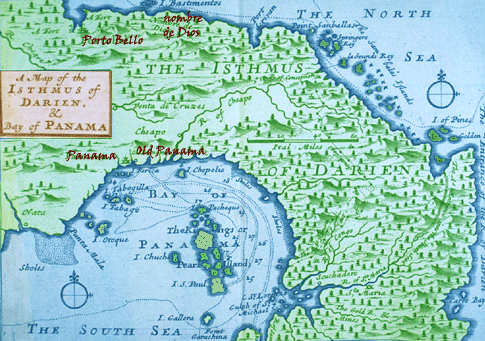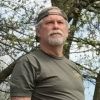The Isthmus of Darien
Today, the Isthmus of Darien is better known as Panama. During the Golden Age of Piracy, Darien could arguably be called the heart of the Spanish Main. This narrow strip of land was about 40 miles (65 km) wide at its narrowest point making it the strategic link between the Pacific and Atlantic Ocean. All of Europe knew this by the 1600s. All of Europe probably wanted to control it. The control of the Isthmus fell into the hands of the Spanish. Unfortunately for Spain, the rest of Europe decided to raid what they couldn’t control.
Today, Panama is still principally a jungle once you get outside its major cities. The Panama Canal, which was first attempted by the French and later realized in 1903 by the Americans, cuts through the center of the country as it travels in a north-south direction across the Isthmus. In the middle of the country is a large lagoon which was formed when parts of the lowlands were flooded as the canal was made. Three hundred years ago, long before the canal was dug and any mosquito abatement had taken place, Darien was a disease infested strip of land connecting North and South America. The low lands were mosquito infested swamps divided by ridge line running more or down the center of the isthmus. Rivers and stream flow from the dissecting ridge lines down to the oceans but there was no river passage from one side to the other. The only way to cross the isthmus was on foot.

Click here to enlarge the map
The Cities
The focal point of Piracy in Darien would have to be Porto Bello, Panama City and the Camaro Real or Kings Highway that, connected the two cities. Porto Bello, on the Atlantic Coast was named by Columbus in 1502, the name meaning “good port”. Despite being discovered in 1502, it did not become a major port until 1597, when the settlement of Nombre de Diós would be abandoned and moved to the “good port”.
Panama City became an active Spanish settlement in 1519 only a few years after Martin Fernandez de Enciso established the colony Santa María de la Antigua del Darien in 1510. A rumor through out the new colony told of large body of water to the south. On September 1, 1513, Vasco Nuñez de Balboa set of from Antigua, with a force of 190 Spaniards and about 1,000 natives searching for a sea that was told to him. After 28 days of walking, Balboa and his men finally reached the Pacific Ocean. As was the custom, Balboa claimed the new ocean in the name of Spain, along with all the land that touched its coast. He called the ocean, the Mar del Sur or South Sea.
Two years later, in 1515, Captain Antonio Tello de Guzmán, set out along the coast of the South Sea and came upon a fishing village inhabited by people who called themselves “Panamas”. Panama City would be established in the vicinity of this village in 1519. Surprisingly, the people of the village knew of a jungle trail that led through the swamps and would lead to the Spanish town of Porto Bello. Guzmán ordered Diego de Alvitez to take a party of 80 men and explore the route. They became the first Spaniard to cross the Rio de los Cocodrilos. This route became the King’s Highway; also known and the Gold Road because it was the route used to transport Gold from Peru across the isthmus to the waiting plate fleets.
Of course the only way to get large sea going craft to the Pacific side of Darien was to sail a ship around the Horn of South America or around the Cape of Good Hope in Africa and then across the Pacific. But once the ships were in the area, they could use Panama City as an excellent staging area. But this would mean that the only way to get stuff out of Peru was to sail back around the Horn or back across the Pacific. It became obvious that it would be more economically sound to keep a Pacific fleet at Panama to exploit Peru and then simply move the new found treasures and supplies across the thin strip of land over to the Atlantic side. From there, the goods could loaded in Galleons moving up the coast of South America, then heading north to Havana and eventually back to Spain.
Spain knew that moving large sums of gold along the King’s Highway would be a dangerous affair. They knew for instance many of the Natives were not happy with the Spaniards conquering them so the native were willing to attack them. They were also the Cimarrona, a loose band of escaped African slaves and deserters from the Spanish navy and army would also cause them trouble The Cimarrona would later be called marooners by the English and the word would become synonymous with pirate..
They also assumed that Porto Bello and other Atlantic ports would be easy targets if attacked form the Sea and took necessary precautions against this type of invasion. They figured Panama was not such a likely target at first, assuming it was just too difficult to reach. They considered the cimarrona and the natives a nuisance. It made no sense to track them down in the swamps and kill them so they ignored them unless they caused trouble.
The Raids
One of the earliest successful attacks on the Isthmus of Darien was by the English privateer Sir Francis Drake. Near the end of 1595 he launched a successful raid against Nombre de Diós but then pushed his luck and headed up the King’s Highway in the hopes of also taking Panama City. Spain met his force along the King’s Highway and pushed his privateer army back to the Atlantic Ocean. After destroying Nombre de Diós Drake and his men retreated to the poorly secured Porto Bello. Drake fell ill at this point and died of fever. He was placed in a casket of lead and buried in the harbor at Porto Bello.
The English then left Darien and despite not taking Panama City, the raid on Nombre de Diós proved to be quite successful. Spain quickly realized the poor defenses at Nombre de Diós and decided to move the settlement to Porto Bello in 1597. However they did amange to fight off the attack on Panama, because the difficulty of crossing the isthmus gave themy plenty of time to react, as they had thought it would. Five year later in 1602, another English buccaneer, Captain William Parker slipped into Porto Bello Harbor and sacked the city; slipping off before the Spaniards could put up a good fight. Have learned from Drakes failure to reach Panama, no attempt was made.
The most noted of all attacks on Porto Bello was that of Sir Henry Morgan’s in 1668. Morgan avoided the sea batteries and attacked the city from the landward side. He sacked the entire city and remained in the city for two weeks. Depending on the accounts, anyone of importance was killed, most of the women were raped and all the treasure was stolen. Spain failed to respond, possible worried about an impending attack on Panama City.
Two years later Morgan returned and attacked El Castillo de San Lorenzo and then proceeded to cross the isthmus in order to sack Panama City. The buccaneers managed to sack Panama City despite having lost most of their men from disease and starvation. It is often reasoned that three major factors led to the easy capture of Panama City. First most of the gold had been hidden or shipped out of the port before the buccaneers arrived, second the Spanish defenders were ill trained militia and finally the fearsome reputation of the buccaneers. Once again the difficulties of crossing the isthmus made it possible for the Spaniards to protect their wealth even though the city was sacked.
While few men died in the capture of the city many of the buccaneers died from disease and starvation. The lack of any real treasure led to speculation that Morgan had struck a deal and taken most of the gold for his self. This led to a mutiny among the buccaneers.
In 1674, a new Panama City was built about 5 miles from the one that Morgan sacked. The new area was believed to be more defendable. It is the location of present day Panama City.
The last attack on Porto Bello by the British occurred on November 21, 1739 when Vice-Admiral Edward Vernon laid siege to the harbor for six days. Afterwards they took the ammunition, stole the best cannons, destroyed the fortifications and took a total of 10,000 pesos before leaving the harbor and most of the town in tact.
The Camaro Real
Buccaneers attempted to raid the Camaro Real or King’s High way on a few occasions but for the most part it was not as easy as it would seem. When the Spaniards moves gold from Panama City to Porto Bellow it was done with heavily guarded mule trains. The schedule for the movement was closely guarded and would often be changed at the last minute to throw off would be ambushers.
As mentioned the trains would be heavily guarded. Scouting parties would often follow in front of and behind the actual mule trains to make sure they could not be surprised. The road it self was also patrolled and strategic points would have guards posted to prevent would be attackers from approaching along the road forcing any pirates to advance through the swamps.
All of this means it was somewhat difficult to sneak up on the gold trains. I also meant that the attacking force would be less rested than the Spaniards who had an easier time using the road. The Spaniards also had the advantage of having their personal goods moved by mules instead of having to carry their food and water. Many a pirate crew attempted to use the local streams, vegetation and animals for food and water only to discover this was a good way to go hungry and get sick.
Once the buccaneers attacked a gold train they would then have to pack the stolen goods back through the jungle because the Spaniards would inevitably get alerted to the ambush and send out forces for a counter attack. And even if they avoided the Spanish counter attack they would have to hope that the ship they came on had not been attacked. You must realize that the ship that brought them would be short staffed because much of the crew was now with the land party. This means the ship was more vulnerable to attack, meaning the crew may sail away when attacked or just be completely wiped out. In all, attacking the gold trains was not as easy as it was believed but the buccaneers did make several attempts and some were successful.
In Conclusion
Probably the most curious foot not in the history of Darien was the three attempts by Scottish refugees to set up a colony on the isthmus. The colony was called Caledonia; the main settlement was New Edinburgh. The first attempt was made in 1698 the last in 1700. The attempts failed for a number of reason but principally because of disease. The last attempt was repulsed almost immediately by Spain.
By 1813, Spain would be losing its grip on its North American colonies and Panama would gain its independence. Unfortunately for Panama, by then most of the wealth of that nation had been taken by Spain or her enemies.

The only author and editor of all pages on the site. Most of what I write about is based on years of book reading on the topic. My first web page was published back in 1994.